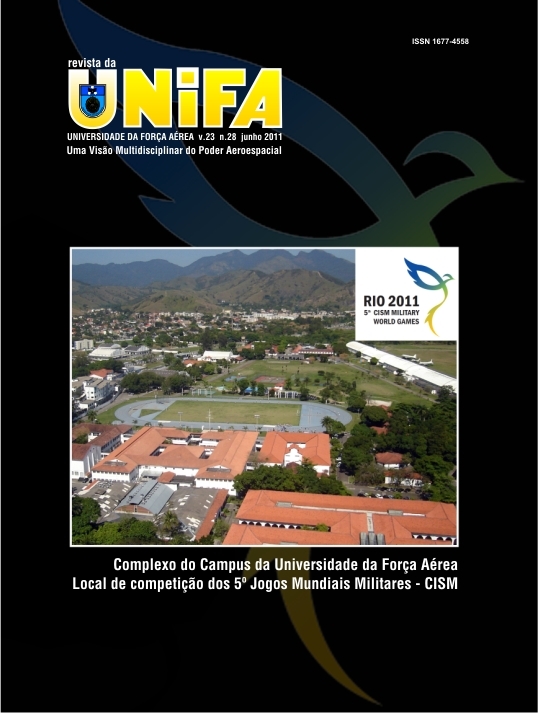The compatibility between the concept of the Brazilian Air Force battle uniforms and the performance environments prospected by the National Defense Strategy
DOI:
https://doi.org/10.22480/revunifa.2011.23.639Keywords:
Battle uniform, Design, National Defense Strategy, Operational environmentAbstract
This research aimed to analyze qualitatively the compatibility between the concept of battle uniforms currently in use in the Brazilian Air Force and the performance environments prospected by the National Defense Strategy to the Force. Pragmatist method was used, based on the peircean semiotic theory and the conceptual foundations of design, to infer the concept which was intrinsic to the 10th uniform from the Regulation of the Uniforms for the Air Force Military Personnel. From this analysis, it was inferred that this uniform was designed as a battle uniform of medium technology, for the Brazilian Air Force military personnel, partially adequate to be employed in campaign, during the day or at night, in the jungle and subtropical rainforest. However, it was identified that the potential operational areas of the Force are occupied by many different biomes in Brazil and worldwide, with the aggravating factor that, in its prioritary operational environment, the Amazon, similar diversity occurs as savannas, grasslands and rainforest coexist in the same biome. Therefore, based on the semiotic-pragmatic logic, this research concluded that the concept of the battle uniform currently in use in the Brazilian Air Force may be considered only partially
compatible with the operational areas prospected by the National Defense Strategy to the Force where the biomes Amazon and Atlantic Rainforest or other tropical moist forests are present and incompatible with all others.
References
ANTTONEN, H. Development of military clothing as a target of research. In: NATO RESEARCH AND TECHNOLOGY ORGANISATION HUMAN
FACTORS AND MEDICINE PANEL - SOLDIERS IN COLD ENVIRONMENTS, 168., 2009, Helsinki. Proceedings... Helsinki: NATO-RTO, 2009.
Disponível em: <ftp://ftp.rta.nato.int/PubFullText/RTO/MP/RTO-MP-HFM-168/$MP-HFM-168-KN4.doc>. Acesso em: 15 ago. 2010.
ARMY-TECHNOLOGY.COM (Ed.). FELIN (Fantassin à Équipements et Liaisons Intégrés): future infantry soldier system, France. Disponível em: <http://www.army-technology.com/projects/felin/>. Acesso em: 18 ago. 2010.
BRASIL. Comando da Aeronáutica. RCA 35-2: regulamento de uniformes para os militares da Aeronáutica. [Brasília, DF], 2005.
BRASIL. IBGE. Mapa de biomas e de vegetação. [S.l.: s.n], 2004. Disponível em: <http://www.ibge.gov.br>. Acesso em: 20 set. 2010.
BRASIL. Ministério da Defesa. Estratégia nacional de defesa. Brasília, DF, 2008. Disponível em: <http://www.defesa.gov.br>. Acesso em: 15 ago. 2010.
CERRI, C. Requisitos de desenvolvimento do 10º. uniforme. [mensagem pessoal] Mensagem recebida por: . em: 21 set. 2010.
ECO, U.Tratado geral de semiótica. 2. ed. São Paulo: Perspectiva, 1991.
ECO, U. et al. Psicologia do vestir. Lisboa: Assírio e Alvim, 1989.
ESTADOS UNIDOS DA AMÉRICA. Ernest E. McConnell. National Research Council (U.S.). Committee on Toxicology. Subcommittee to Review Permethrin Toxicity from Military Uniforms. Board on Environmental Studies and Toxicology. Health effects of permethrin-impregnated army battle-dress uniforms. Washington, D.C.. National Academy Press, 1994. Disponível em:<http://books.google.com.br>. Acesso em: 22 set. 2010.
ESTADOS UNIDOS DA AMÉRICA. Government Accountability Office. GAO-10-669R de 28 de maio de 2010. Warfighter Support: Observations on DOD’s Ground Combat Uniforms. Disponível em: <http://www.gao.gov>. Acesso em: 22 set. 2010.
ESTADOS UNIDOS DA AMÉRICA. Kurt D. Wilson. Defense Logistics Agency. Defense Supply Center Philadelphia Clothing & Textiles. Clothings and Textiles. Filadélfia, 2009. Disponível em: . Acesso em: 15 ago. 2010.
FEDERATION OF AMERICAN SCIENTISTS (Estados Unidos da América). Military Analysis Network. BDU: battle dress uniforms. Disponível em: < http://www.fas.org/man/dod-101/sys/land/bdu.htm>. Acesso em: 02 out. 2010.
GIL, A. C. Como elaborar projeto de pesquisa: 4. ed. São Paulo: Atlas, 2009.
GOMES FILHO, J. Design do objeto. São Paulo: Escrituras, 2006.
HOUAISS, A.; VILLAR, M. S. Minidicionário Houaiss da língua portuguesa. Rio de Janeiro: Objetiva, 2001.
INSTYTUTU BIOPOLIMERÓW I W ÓKIEN CHEMICZNYCH (Polônia). Fibre and Textiles in Eastern Europe. Disponível em: <http://fibtex.lodz.pl/en>. Acesso em: 18 ago. 2010.
JAVAID, A. World market and production of textile used in military. Disponível em: <http://www.scribd.com/doc/22667423/World-Market-and-production-ofTextile-used-in-Military>. Acesso em: 28 ago. 2010.
LÖBACH, B. Design industrial: bases para a configuração dos produtos industriais. Rio de Janeiro: Edgard Blucher, 2001.
NACIF, M. C. V. O vestuário como princípio de leitura do mundo. Rio de Janeiro: UFRJ, 2007.
MAHMOOD GROUP (Paquistão) (Ed.). The functions of clothing. Disponível em: <http://www.mahmoodgroup. com/functionofclothing/index.html>. Acesso em: 15 ago. 2010.
PEIRCE, C. S. Semiótica. 2. ed. São Paulo: Perspectiva, 1995.
ROMANINI, V. Design como comunicação: uma abordagem semiótica. In: SEMINÁRIO DO CURSO DE DESIGN DA FAU-USP - DESIGN: QUO VADIS?, 1., 2008, São Paulo. Seminário. São Paulo: USP, 2008. p. 1 - 5. Disponível em: . Acesso em: 02 out. 2010.
SATAM, D. S. Global competitiveness of U.S. military textiles industry. North Carolina State University: 2007. SDAB-AB4. Proposta de atualização do RUMAER para o ano de 2010. [mensagem pessoal]. Mensagem recebida por . em 21 set. 2010.
SILVA, M. F. da. Asa de corvo: uma abordagem semiótica para principiantes. Revista do Gelne: grupo de estudos lingüísticos do nordeste, Fortaleza, v. 4, n. 2, p.10-20, 2002. Semestral.
SOEDERBERG, A.; WEDELL-WEDELLSBORG, M. Challenges to uniformity: managing the changing dentities of multinational military units. Artigo. Royal Danish Defense College, 2005. Disponível em: . Acesso em: 15 ago. 2010.
WILSON, A. Trends in technical textiles: global technical textile leaders converge to discuss the industry’s future and some recent innovations. Specialty Fabrics Review, Saint Paul, Projects; Latest projects; fev. 2010. Disponível em: <http://specialtyfabricsreview.com/articles/0210_wv_technical.html>. Acesso em: 11 ago. 2010.
WWF INTERNATIONAL. Habitats: simplified explanations. Disponível em:< http://wwf.panda.org/ about_our_earth/ecoregions/about/habitat_types/habitats/>. Acesso em: 20 out. 2010.
Downloads
Published
Issue
Section
License
Copyright (c) 2011 Fernanda Maria Andrade Bittencourt

This work is licensed under a Creative Commons Attribution-NonCommercial 4.0 International License.
Revista da UNIFA permite que o (s) autor (es) mantenha(m) seus direitos autorais sem restrições. Atribuição-NãoComercial 4.0 Internacional (CC BY-NC 4.0) - Revista da UNIFA é regida pela licença CC-BY-NC









